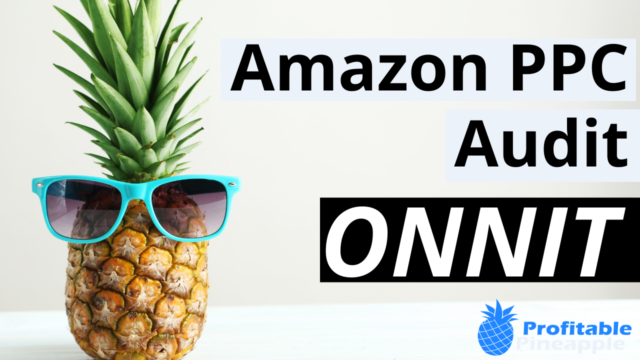Amazon listing optimization is another HUGE part of your Amazon success and for some reason it is often one of the most overlooked parts of your Amazon PPC strategy. The difference between having a conversion rate of 10% and a conversion rate of 20% is huge. It could mean thousands, if not hundreds of thousands, of dollars in lost or gained profit over the lifetime of a product and over the lifetime of your business.
In the previous articles on optimizing your Amazon PPC, we discussed tracking and measuring your results, researching your competitors, and Amazon keyword research. In this article we are moving on to step four, which is going over 11 best practices for Amazon listing optimization. I would highly recommend going back and reading/watching the previous examples as they will all play a role in Amazon listing optimization.
Make sure to check out my FREE 8-week Amazon PPC Masterclass by clicking here.
11 Best Amazon Listing Optimization Practices
1. Amazon Keyword Research: The First Amazon Listing Optimization Best Practice
This is where your Amazon listing optimization starts, with great keyword research. Keyword research is essentially the map that will guide the rest of your listing. Our goal with Amazon keyword research is two fold. The first goal is to find highly searched keywords to use in our title, bullets, backend search terms, photos, enhanced brand content, and more. The second goal is to find mid and long-tail keywords to go after with Amazon PPC campaigns that won’t cost you a fortune. If you don’t have a budget, then go after the highly searched words, but know that you will spend a lot more.
Check out my complete video and how to guide here on Amazon Keyword Research.
2. Title: The Second Amazon Listing Optimization Best Practice
The title is one of the most important factors (next to your hero image) in getting someone to click on your listing. You want to use keywords, powerful adjectives (delux, premium, ultra), sell your customers on why they should buy, and peak curiosity to get them to click. Try to surprise them with your title.
In step two of our Amazon PPC Masterclass we discussed competitor analysis. Check out that video and blog post here. With our competitor analysis we looked at the frequency of words that the top sellers use in their listings. Let’s go back to our eyelid wipes example and look at the frequency count.
As you can see, there are a few words that are used multiple times over multiple listings. You should NOT ignore these words as the best sellers are using them, therefore you should be using them too. Without doing keyword research, I will craft a title around the words that I see here.
Here are some examples:
Eyelid Wipes for Cleansing the Sensitive Skin Around Your Eyes And on Your Lid (30 Count)
Or
Eyelid Wipes for Facial Cleansing, Eye Makeup Removal, and Dry, Sensitive, Skin on the Lid (30 Count)
This is just how I like to start my title research. After I get the word frequency count, I then dig into my keyword research and figure out what terms are getting the most searches with a great Magnet IQ score and add those in as well. Learn more about the Magnet IQ score and how to use it at the bottom of this article.
Again going with our example of eyelid wipes (keyword research process on our eyelid wipes is here), We look at both the SHOP and the BROWSE category for these keywords to craft the perfect title.
Taking both the shop and browse keywords into account, we will formulate a title based on a higher search volume and higher Magnet IQ Score, combined with our word frequency account from above.
Also, before creating our titles, let’s look at Amazon’s title requirements, according to their website.
Title requirements apply to all non-media products on all of Amazon’s worldwide marketplaces, whether you use Fulfillment by Amazon or the Merchant Fulfillment Network. Amazon has four main criteria for product titles:
- Titles must not exceed 200 characters, including spaces (which can vary depending on category).
- They must not contain promotional phrases, such as “free shipping”, “100% quality guaranteed”.
- Titles must not contain characters for decoration, such as ~ ! * $ ? _ ~ { } # < > | * ; ^ ¬ ¦
- Titles must contain product-identifying information, such as “hiking boots” or “umbrella”.
With all that in mind let’s show you some examples from above (and these examples do NOT take into account FDA requirements for structure/function disease claims). If your product must abide by these guidelines, you’ll need to work around this.
Premium Eyelid Scrub Wipes for Blepharitis, Stye, Chalazion, Ocular Rosacea, and Dry Eye Treatment | Great for Cleansing the Sensitive Skin Around Your Eyes And on Your Lid (30 Count)
Or
Premium Eyelid Wipes for Blepharitis, Stye, Chalazion, Ocular Rosacea, and Dry Eye Treatment | Great for Facial Cleansing, Eye Makeup Removal, and Dry, Sensitive, Skin on the Lid (30 Count)
3. Bullets: The Third Amazon Listing Optimization Best Practice
With your bullets you want to evoke emotion and relate to your customer. Think like the customer and ask yourself, what wording will make me want to buy this product? Focus on the BENEFITS of your product and not the features.
There are a few exercises I like to do in order to find benefits of a certain product. First, you can check out your competitors reviews and look for very excited reviews. Second, you can also put into Google: “why people buy…” and get ideas that way. Finally, ask your customers why they bought your product and not your competitor’s.
Write down your initial five biggest strengths as to why someone would and why someone should buy your product. Use as many of the seed keywords and other words that were frequently used in here. Then ask yourself “why is this important?”
Most of the time we write down the features of a product, which does not lead to any emotion from the buyer. Ask yourself why that feature is important, and that is usually the benefit of the product. If you want to get even more emotional, ask the same question of “Why is this important?” to that benefit that you just came up with.
Here is a list of the features of our eyelid wipes
- Powerful cleansing agent
- Removes dead skin cells
- Gentle on your skin
- Exfoliates skin
- Eye makeup remover
As you can see, these don’t evoke that much emotion in the buyer. They are mostly features of the product. Now, let’s ask the question “Why is this important?”
Here is a list of benefits for out eyelid wipes:
- Decreases eyelid bacterial growth
- Promotes younger, shinier looking eyelids
- Lifts and firms upper eyelids
- Reduces eyelid wrinkles
- Removes unwanted makeup
The benefits of a product tells the customer what is in it FOR THEM, not what the fancy bells and whistles (features) of your product are.
After we do that, we want to dig even deeper and write out what life will be like AFTER they buy our product. Here are the final bullets:
- DECREASES EYELID BACTERIAL GROWTH – By Cleaning your Eyelids and Lashes daily, you remove unwanted dead skin cells and debris. The removal of old makeup promotes healthy overall eye health.
- PROMOTES YOUNGER, SHINIER LOOKING EYELIDS – EXFOLIATES YOUR EYELIDS – Your eyes need daily gentle exfoliating just like the rest of your body. By practicing daily eyelid exfoliation, you remove dead older looking cells on your eyelids. By removing oily dead skin cells, your eyelids will be looking more youthful. Excess dead cell buildup can lead to styes and other eye problems.
- LIFTS AND FIRMS UPPER EYELIDS – Exfoliating also promotes collagen production which can make that thin, fragile tissue stronger and more resilient. After exfoliation all skin is more absorbent and receptive to the benefits of corrective skin products and your eyes are no exception.
- REDUCES EYELID WRINKLES – Gentle daily exfoliation of the eye area can help it look younger and glowing by creating a smoother surface that better reflects light. A gentle eye exfoliator will keep the skin elastic enough to flatten out and look youthful again.
- REMOVES UNWANTED MAKEUP – It is recommended by Optometrists and Ophthalmologists to to gently exfoliate the eyelids after removing your makeup—every night! Very lightly sweep a soft, moist washcloth over the surfaces of your eyelids and through the roots of your lashes. This will lightly remove loose surface cells and prevent buildup on your lash line.
The official character limit is 1000 characters (250 words). Other points that might be helpful is including any guarantee or warranty that you offer, answer customer objections, and put the most important benefit at the top, and let them know how it will help solve the problem they are searching for.
4. Photos: The Fourth Amazon Listing Optimization Best Practice
You MUST, and I mean MUST get professional images done. Have you ever seen a Coca-Cola ad that looks like it was poorly lit and you can barely see the image? Likely not.
Professional photos probably have the best return on investment that I have seen in our Amazon business. From the hero image all the way to the lifestyle images, invest in a product photographer that knows physical products and especially Amazon.
In your images, be sure to put the benefits of the product and make sure that you show happy, emotional people. Treat these like a second set of bullets. Here is a photographer that I have used and I recommend.
Below are some examples of photos.
Example of an all white background hero image.
Examples of lifestyle images with and without benefits on the photo
5. Enhanced Brand Content: The Fifth Amazon Listing Optimization Best Practice
Enhanced brand content, or Amazon EBC, replaces the description with visually rich content and is simply done by combining everything you did with bullets and photos and reformatting them into different sized photos to fit the EBC format.
Due to mobile shopping becoming a bigger and bigger part of Amazon’s sales, you should absolutely take your time on this. This is the first thing your customers see after the photos and price.
On top of putting benefits and features of your product, you can also showcase what your brand is all about. At Eye Love, we give a portion of all profits back to those who can neither afford nor obtain eye exams, glasses, and sunglasses. Check out our whole mission here:
6. Backend Search Terms: The Sixth Amazon Listing Optimization Best Practice
This process is pretty easy. I usually take my top 15 to 20 keywords from my Browse and Shop and combine them with the most frequently used words list. I then use the Frankenstein by Helium 10 to condense the list of keywords.
After looking at the list I then manually delete words that are in my title, bullets, and in the list that Amazon says to not include until I get to around 150 characters or 250 bytes.
Here is my final list: stye treatment chalazion blepharitis cleaner cleanser relief itchy eyelids scrub lid pads individual makeup remover cleansing skin dry sensitive eyes
Here is Amazon’s guide on using search terms effectively:
In order for customers to find your products on Amazon, it’s important to provide Search Terms they might use when searching for what they want to buy. Amazon limits the length of the Search Terms attribute to less than 250 bytes. The Search Terms limit applies to newly-registered as well as existing ASINs.
Tips for optimizing your Search Terms:
- Stay under length limit.
- Include synonyms.
- Make sure to include spelling variations, no need for misspellings.
- Include abbreviations and alternate names.
- You can use all lower case.
- You don’t need punctuation, such as: “;”, “:”, “-“.
- Separate words with spaces.
- Don’t repeat words within the Search Terms field.
- Also, don’t include your brand or other brand names in Search Terms.
- Don’t include ASINs in Search Terms.
- No need for stop words such as “a,” “an,” “and,” “by,” “for,” “of,” “the,” “with,” and so on.
- Use singular or plural, no need for both.
- No temporary statements such as “new,” or “on sale now.”
- Don’t use subjective claims, such as “best,” “cheapest,” “amazing,” and so on.
- Don’t add abusive or offensive terms.
7. Descriptions: The Seventh Amazon Listing Optimization Best Practice
Although enhanced brand content will take the place of your description, I still recommend putting a description in with simple line breaks, which are allowed by Amazon, <br></br>. I recommend putting multiple keywords into these sentences but still make sure it makes sense. Is this necessary? Probably not, but we still do it. Here is an example:
</br> Premium Eyelid Scrub Wipes for Blepharitis, Stye, Chalazion, Ocular Rosacea, and Dry Eye Treatment | Great for Cleansing the Sensitive Skin Around Your Eyes And on Your Lid (30 Count)
</br> Individual makeup remover and lid wipes for blepharitis and eyelid cleansing
</br> Dry eye wipes for dry eye relief and dry eyelids treatment
</br> Eye allergy relief eyelid wash and dry eye therapy
8. Reviews and Ratings: The Eighth Amazon Listing Optimization Best Practice
Reviews are the social proof of your business and show that people are buying your product. It is like a busy restaurant versus a restaurant that has no one in it… Which one are you going to? They are also important (we think) when it comes to Amazon’s algorithm.
There are three great ways to build up reviews. Number one… don’t source a terrible product. Make sure you have a high-quality, premium product. Number two is to make sure you have a great and COMPLIANT automated email campaign sequence post-purchase. Number three is build a list of raving fans who have purchased your products and cater to their every need. You only need about 100 of these raving fans to get a lot of reviews.
When I wrote this blog post, we just released our new eye cream and face moisturizer. Is this product competitive? VERY… Are we still going to launch it? YES! We do this because we have a group of raving fans that will try it out and give their honest feedback. After that they will tell their friends about it and word spreads. We launched this product on September 1st, 2019 and as of today we are selling 3-7 per day WITHOUT Amazon PPC, which we will turn on when we have more stock.
Do you know how we got the initial reviews? I called every single person that purchased the first 300 to ask them for their feedback. I then pointed them to leave what they said as a review on Amazon. Focus on the customer and focus on your customer service and multiple reviews and a great rating will come. We are averaging about one review per day since launch.
9. Software to Audit Your Listing: The Ninth Amazon Listing Optimization Best Practice
We use the Helium-10 Chrome Extension tool, which is a great FREE Amazon Listing Optimization Software Tool, which you can get FREE by clicking here (affiliate link). This tool essentially audits your listing and allows you to see some areas where you can improve.
After installing, just hover your mouse over the Helium 10 evaluation result to see where you can improve. It will evaluate the number of images, image dimensions, main image background, title, bullets, description, rating, and reviews and assess a score to you. Try to improve your score until you get to a 10 out of 10.
10. Hire a Professional Copywriter: The Tenth Amazon Listing Optimization Best Practice
Consider hiring a professional copywriter to audit and rewrite/write your listing. Sometimes having an outsider look at your listing will bring up things that you would have never thought of. If you are interested in having us do this for you, schedule a time to chat with me about how we can help (the first call is free). If I cannot help you then I will point you in the right direction to someone that can. Click here to schedule with me.
11. Never Stop Split Testing: The Eleventh and Final Amazon Listing Optimization Best Practice
Now that you have optimized everything on your listing from top to bottom, it is time to start all over again. Split testing (also referred to as A/B testing or multivariate testing) is a method of conducting controlled, randomized experiments with the goal of improving a website metric, such as clicks, form completions, or purchases.
Why should you split test?
PPC is an effective marketing tool, but it can also be a very expensive one if all the basics and key strategies are not performed to the letter. Using A/B Split Testing, digital marketers can further improve and optimize their campaigns to generate better and more targeted results.
Split testing is such a vital part of your Amazon business that you need to be doing it at all times. A photograph that increases your conversion by 5% can mean thousands of dollars more in your pocket (like stated above).
Here is what we recommend when it comes to split testing an Amazon listing:
- Main image – try different angles, product parts, ask your photographer to mix it up
- Title – longer vs shorter, different benefits
- Price – Split test a $1-$5 increase in price
- Main image (again)
- Secondary images – man vs women, adults vs children, infographics
- Title (again)
- Bullets
- Price
Best practices for Amazon split testing:
- Only split test one related factor at a time
- Allow at least 14 days of rotations to take place
- Have patience
- Record everything
We also recommend split testing and recording different headlines in your Sponsored Brands, or headline search ads. Try different benefits and wording.
I realize that this was a lot to take in regarding Amazon listing optimization, but this is one of the most important steps in Amazon PPC. In the next step we will be going back to Amazon PPC and go over campaign structure, setting up your first campaign, or cleaning up your existing campaigns.
RELATED ARTICLE: 5 Golden Rules of Amazon Split Testing to Easily Increase Amazon Sales
FAQs About Amazon Listing Optimization
What’s Next With Your Amazon PPC?
This is only step 4 in your new Amazon PPC Strategy. Click here to get all the Amazon PPC lessons emailed right to your inbox once per week. This will be an actionable lesson every week to take your Amazon PPC to the next level.


![The BEST Reverse ASIN Lookup + How To Use Guide [HELIUM 10 CEREBRO]](https://salesfunnelhq.com/wp-content/uploads/2020/07/Copy_of_Amazon_PPC_Negative_Keywords-e1594679511607.png)
![Amazon FBA Sellers Don’t Get Shutdown Doing This [BREAKING NEWS]](https://salesfunnelhq.com/wp-content/uploads/2019/12/Amazon-FBA-Sellers-Avoid-Suspension-Changes.png)


